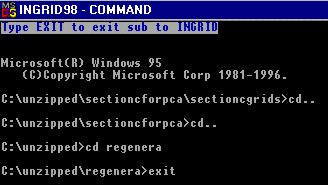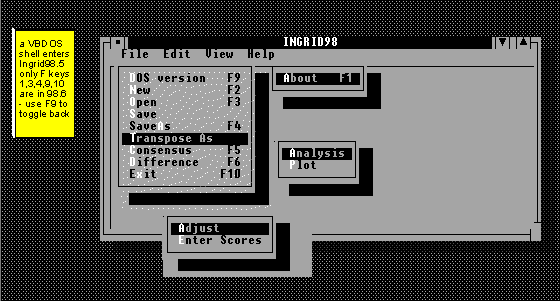
Enter MAXIMUM - ROWS,COLUMNS?

N.B. This gave an effective level of need-to-know security. Beta versions up to Ingrid98.e read all earlier files to allow for backward compatibility. From then on you had to manually update the version number and fix formats to run earlier files. To run this tutorial example - download Grid22.txt
In Ingrid98.d the expanded labels were stored to the right of the row data for easy identification. These expanded labels were entered here into the text file and when it was later saved by Ingrid98.d these expanded labels were added to the initial group of short labels when the grid was saved.
This allowed you to cut & paste from Excel a table that contained both row and column labels and data as well as expanded row labels to the right of the data. Expanded column labels no longer needed to be manually entered.
From Ingrid98.e (build 1409) input was supported for both SPACE and TAB field delimiters but only within the table portion of the inGridX text file.
The procedures for preparing an inGridX text file using data from Excel were simplified as follows:-
(1) Select the cells from your spreadsheet to include row and column labels and data and paste into your inGridX text file.
(2) Either set the right number of blank lines or ignore the ancillary label blocks by naming the elements ELEMENTS and the constructs CONSTRUCTS and only add a single blank line to separate each section of the inGridX text file. NOTE: These capitalized names are lower-cased on saving the grid to provide a one time only input feature.
(3) After ensuring that the header of the inGridX text file correctly shows the right number of rows and columns, run inGridX to process and re-save this file. The ancillary label blocks were then added to the file.
If the grid had already been analyzed it was analyzed again with the data from the title screens and from section 1 to 9 being appended to the input file and a plot was done. Then HTML tags linking the terms with the plots to Infoseek were written to the text file. You could then put this and a screen capture into a template.
For creating HTML area tags, the default font width and height was set in Ingrid98.e (from build 1408) to be 7x12. If you wanted to create HTML area tags with a different font size, you needed to use a command line option when you ran the inGridX program, e.g., to set the font to 8x16 you must set your command line as in the following example.
c:\ ingrid98.exe /F=8x16
I chose this size screen when I coded the automatic mapping routines into Ingrid96.2 so that the ImageGrid would minimally fit on a 800x600 screen. To make your own automatic mapping to the Internet you need to capture the final plot screens to an animated image file. Later from the main menu after the grid had been plotted you can save (use function F4)and then, complete Infoseek search engine links will be created and stored. By editing a cloned, original regenera.htm, file you could replace the image and the existing search links with those from the saved text file and publish the results. So, each label would take a user to the net. I included the label in the search string so that you can create cascading inGridX plots.
Things would happen later, providing you register your resultant URL with the search engine.
This allowed for the inGridX text data including component loadings to be easily cut and pasted back into Excel where you then only chose Data Text to Columns using multiple SPACE delimiters and QUOTES as text qualifiers.

It was worth considering NORMALIZING the individual grids first. This had the effect of removing different uses of the grading scale ( i.e., some people used the full range, some a narrow band, some the highs only etc.). After the grids were combined the analysis took place straight away.




From Ingrid98.e (build 141) the TransposeAs option was available to save a grid with all the rows and columns reversed. The grid was automatically reloaded in its transposed form with its analyzed flag set to off loosing the weighting column. You also activated this feature from the DOS version by typing the command Swap in the Option Required field.